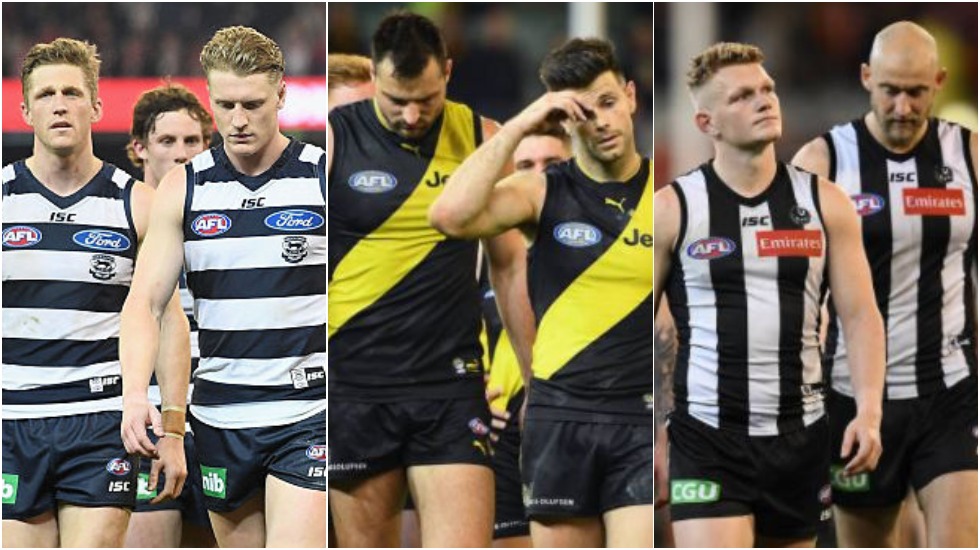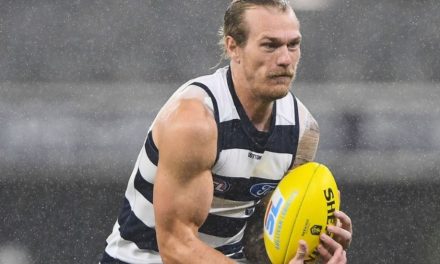Geelong in 2016, Richmond 2018, Collingwood 2019: Qualifying final winners caught on the hop in their preliminary finals.
Round 23’s Carlton-Collingwood clash was one of the biggest home-and-away games the AFL era had seen, an absolute thriller in the second-to-last of 198 regular season games.
The buzz around the game was electric, the finals beckoned. And after an 11-day wait, here they finally are. Umm … OK. Nice way to stop a vibe in its tracks, AFL. Once again, the pre-finals bye has effectively neutered the feverish appetite for more.
It’s been annoying, to say the least. But the needless wait is far from the biggest issue here (and yes, I have campaigned relentlessly on this since 2016). The AFL’s determination back then to crack a walnut with a sledgehammer has left the game with a potentially compromised premiership race.
The walnut, if you can’t remember, was Ross Lyon’s Fremantle a couple of times and Brad Scott’s North Melbourne once over the 2013-15 period resting up to half a senior team for the final round with their final ladder spots already locked in and finals looming the following week.
It’s the sort of scenario with which the round ball game in Europe and its frantic schedule deals on a weekly basis without batting an eyelid.
But fears about the impact on betting and potential accompanying legal action spooked the AFL so much it decided to slot a week’s break in the schedule between Round 23 and the first week of finals in order to give teams a break and prevent coaches pulling players out of effectively dead rubbers.
What it foolishly also didn’t account for was the extent to which that extra week’s rest changed the entire dynamic of the top eight right from the word go in 2016, the first year of the bye.
That, of course, was when the Western Bulldogs came from seventh to win four finals in a row on their way to the flag. The first of those was in Perth against West Coast, a game in which the Dogs, thanks to the extra recovery time, regained a clutch of key senior players who had been out injured, almost all of whom wouldn’t have come up without the extra week.
Dogs fans get understandably annoyed by the suggestion the pre-finals bye “gifted” them a flag. Of course they still had to win another three knockout finals. They had also finished seventh with a record 15 wins, often enough to give teams a top four sport. They were worthy premiers.
My beef has always been far more with the penalty the extra week of ends up imposing on teams who finish in the top four then win their qualifying finals.
PLEASE HELP US CONTINUE TO THRIVE BY BECOMING AN OFFICIAL FOOTYOLOGY PATRON. JUST CLICK THIS LINK.
It means that by the time they play in their preliminary finals, they have played just one game of football in around 27 days after having played every six or seven days for nearly half a year.
Has that change really had that much impact? Well, consider the following numbers.
Prior to the introduction of the pre-finals bye in 2016, 17 of the previous 18 preliminary finals (94 per cent) from 2007-15 had been won by a team which had won its qualifying final, had a week off, then took on a more-fatigued opponent which had been playing every week for months.
In the five years of the pre-finals bye from 2016-20 (remember last year it shifted to pre-grand final) we had 10 preliminary finals. The record of qualifying final winners in them was 4-6. That winning strike rate fell from 94 percent to just 40.
That is a massive, unarguable shift. It underlines just how costly really is the interruption to momentum, hardly surprising when teams are going from playing every week to one game in 27-odd days.
Indeed, for Collingwood in 2019, it was just one game in 29 days, nearly a full month. Was it really any wonder the Pies finally “woke up” in the preliminary final they lost by a kick to GWS only at three-quarter time?
Just as Geelong was caught on the hop in the 2016 preliminary final when it conceded seven goals to nothing against Sydney, or Richmond in that famous preliminary final upset at the hands of Collingwood in 2018.
And who could seriously argue that two years ago, two relative finals “newbies” in Port Adelaide and Brisbane, weren’t disadvantaged by their lack of routine against two far more experienced opponents in Richmond and Geelong when the Power and Lions both lost their preliminaries after winning the qualifying final?
This year, with Richmond lurking in the bottom half of the eight, there would have been as good a chance as we’ve seen of a battle-hardened, experienced team winning every week on its way to a flag without a break, let alone now with the aid of one.
Yes, the top eight this year is as even as it’s ever been. But doesn’t that just add to the argument that a team good enough to best that opposition and finish top four deserves any advantage it gets?
If teams who put in all that sweat and toil to finish top four, then win their first final, end up effectively penalised for their success, as that miserable 40 per cent figure of qualifying final winners in preliminary finals under the pre-finals bye arrangement strongly indicates, what’s the point of the effort?
I’ve said repeatedly the pre-finals bye was a bad idea. I’m struggling to comprehend any rationale for going back to it again in 2022 after last year going with a pre-grand final bye for Covid reasons.
And I really don’t think it’s overly-dramatic to suggest it compromises the credentials of the eventual premier.
If we see yet another two qualifying final winners shot down on preliminary final day this season, hopefully more people will realise the extent to which we risk screwing up the very thing an entire football season is about.
An earlier version of this article appeared at ESPN.











